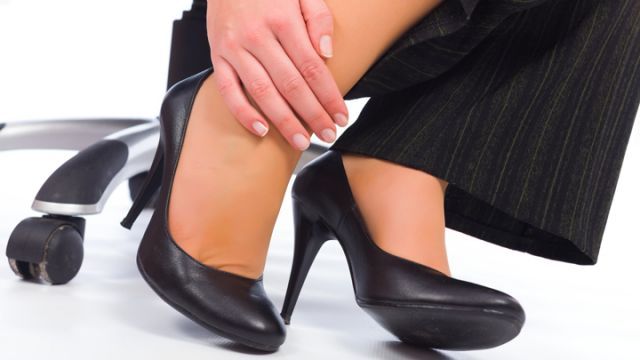
There’s no question high heels are sexy, and for that reason they’re hard to give up. Just remember you aren’t always going to be young, and you want to avoid constant heel and foot pain as you age.
High heel hazards
If you’re one of those women who wear sneakers or other sensible shoes en route to work, but change into heels once you reach the office, you know high heels are hazardous. You’re far more likely to hurt yourself when wearing high heels than other forms of footwear. High heel wearers fall more frequently, and may hurt their hands and arms trying to break these falls. The most common injuries are ankle sprains and strains.
Out of alignment
High heels put your body out of alignment. Your body ideally is centered from head to toe, according to the American Osteopathic Association. Wearing high heels cause your feet to stay angled, and consequently muscles and joints are pulled out of alignment. The long-term result isn’t just pain in your feet, but in your shoulders, neck and back from the constant misalignment.
Bunions and other foot issues
If you love the sexy look of high heels, you probably also want your feet to remain pretty. Unfortunately, high heels and attractive feet become mutually exclusive over time. Long-time high heel aficionados often suffer from bunions, bony bumps forming at the base of your big toe. This hard knob sticks out of the side of your foot, causing pain and looking terrible. If conservative treatments — such as wearing comfortable shoes and bandaging the feet — don’t offer relief, your bunion might require surgical correction. Other foot issues caused or exacerbated by high heels include:
- Calluses: Also known as keratomas, these thick skin patches are unsightly, and can become infected.
- Corns: These dead, painful skin patches occur on the sides and tops of feet and toes.
- Heel pain: Pain in this part of the foot can become disabling.
These are not feet you want to show off in pretty sandals.
Varicose veins
High heels are bad for your veins. If you’re a high heel devotee, you’re more likely to develop those unsightly spider and varicose veins than those who prefer flats. While varicose veins are primarily a cosmetic issue, they occasionally prove dangerous — even life-threatening. Skin around the vein may ulcerate, or a blood clot could form.
When you walk normally, the venous “pumps” in your calf and foot work in tandem to direct blood flow. Off the floor, the veins in your foot fill with blood. When the foot comes into contact with the ground, blood heads into the calf’s veins. Your calf muscles contract and push blood up into the leg’s deep veins. When you wear heels, your normal walking motion changes, which you realize the moment you start moving in these shoes. Your weight shifts to your toes, and the calf muscles remain contracted. You don’t receive as much blood to the feet and your calf muscles don’t pump efficiently. That means blood begins pooling in your legs, eventually leading to varicose veins.
For special occasions
There’s little harm in wearing high heels on special occasions, but avoid wearing them daily or even weekly. When you put on heels, wear compression stockings along with them to help your veins pump properly. You can purchase fashionable compression hose at pharmacies and medical supply outlets. If you have a friend working as a nurse, odds are she can tell you where to buy attractive compression hose.
If giving up heels is too much to ask, go lower. Kitten heels are making a comeback, and are far easier to move in than high heels. There’s no shortage of attractive — and sexy — flat styles.
People generally take their feet for granted until there’s a problem. Opting for comfortable but attractive shoes today rather than heels means you might not suffer from pain later in life that limits your mobility, results in weight gain and prevents you from enjoying life.
—Jane Meggitt

